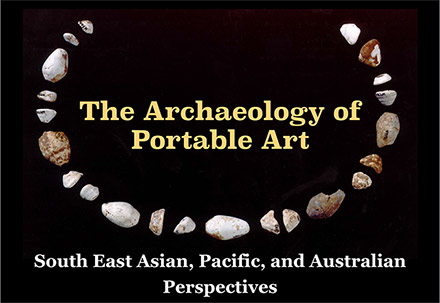
Australian National University, Canberra
23rd - 24th May 2015
This symposium aims to reignite the dialogue about portable art across Island South East Asia, the Pacific and Australia and by doing so review future directions for research. Specific themes are: object histories; use of ethnography/museum collections for informing archaeological research; use of ‘intangible technologies’ and organic artefacts for expressing community affiliation/identity; cognitive development, the role of portable art in Pleistocene and Holocene expansions; and experimental studies.
For further information and registration, visit The Archaeology of Portable Art Symposium webpage.
Symposium flyer (241K PDF)
Plenary Speakers:
Prof. Francesco d’Errico (Université Bordeaux 1, UMR, CNRS, PACEA)
Dr Stephen Loring (Smithsonian National Museum of Natural History)
What’s the Story?
Experts from Island South East Asia, the Pacific and Australia have been invited to come together in the spirit of shared learning, to discuss a range of themes surrounding the archaeology of ‘portable art’. We are also inviting paper and posters to be presented by interested researchers. See below for details on how to submit your paper or poster abstract.
We invite all interested students and researchers to attend what is likely to be a stimulating symposium.
What is ‘Portable Art’?
For this symposium, we are defining ‘portable art’ as “small examples of prehistoric art that could be carried from place to place”. These artefacts may include not only pieces of personal ornamentation, but also any item which has a symbolic or social function. Examples include: projectile points made from various raw materials, ceramics, ‘message sticks’, shields, or any day-to-day item in which ‘messages’ are held in and transmitted through their morphology and/or decoration.
Targeted Themes
- Object histories
- The use of ethnographic and museum collections for informing archaeological research
- The use of ‘intangible’ and/or organic technologies for expressing community affiliations/identity
- The use of ‘intangible’ and/or organic technologies for expressing individual identity/status
- Cognitive development
- The role of portable art in Pleistocene and Holocene expansions
- Experimental studies
Events
‘La Couleur des Ovahimba’
Screening of a film focused on the use of pigment by the Ovahimba women of north Namibia and its importance for understanding Middle Stone Age (MSA) pigment use.
When: Saturday 23 May 2015
2015 Mulvaney Lecture
Prof. Francesco d’Errico
When: Friday 22 May 2015
Where: Manning Clark Lecture Theatre, ANU
Microscopy Workshop
With Prof. Francesco d’Errico - covering the basics of portable art analysis.
When: Monday 25 May 2015
Where: Teaching Lab, Coombs Building, ANU
Portable Art Symposium
When: Saturday 23 - Sunday 24 May 2015
Paper Proposals
If you would like to propose a paper for the symposium, please contact either: Duncan Wright (duncan.wright@anu.edu.au) or Michelle Langley (michelle.langley@anu.edu.au), with the following details:
‣ Presentation title
‣ Author details (name, affiliations, contact email address)
‣ Abstract between 200 - 250 words.
Deadline for paper proposals is February 15th 2015.